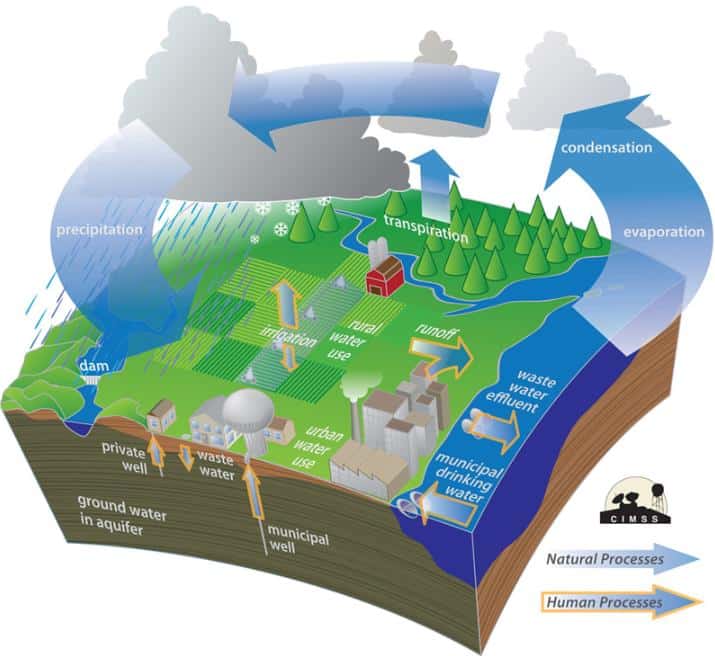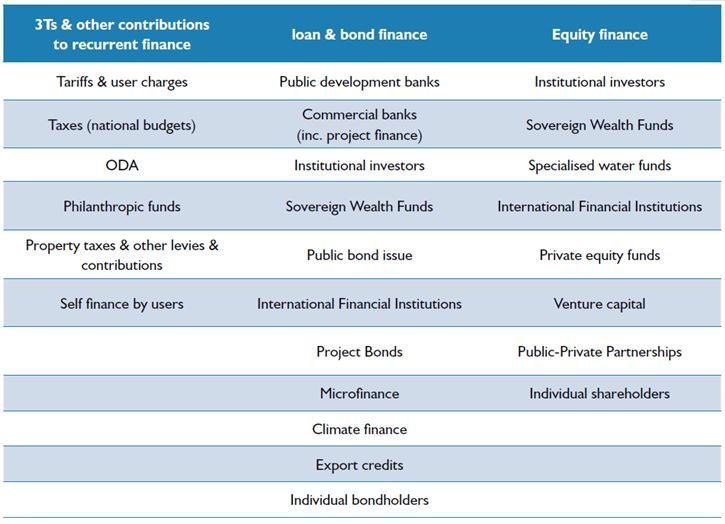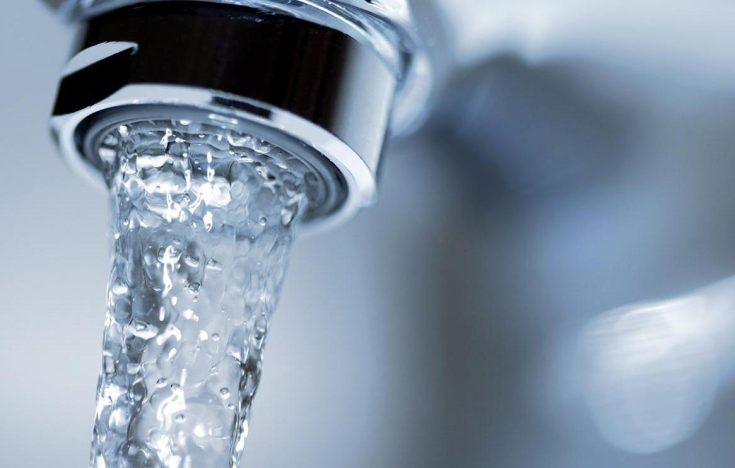Water
accounts for 71% of Earth’s surface. In its many forms, from oceans to rivers,
it is the core element humanity is based upon.
Human
society has developed around fresh water sources, allowing for population
growth, the birth of agrarian societies, domestication of animals, and later,
manufacturing and industry.
But
today this central element of life and of society appears less of a plentiful
commodity and, increasingly, as a rare and precious resource that needs to be
protected and preserved. 3.9 billion people are expected to live in severely
water-depressed areas by 2050. That’s more than 40% of the world’s population
(source: UNU-INWEH, 2017).
Rapid
population growth and economic expansion is putting heightened pressure on
demand, while climate change is furthering pressure on the supply chain –
represented by nature’s water cycle. With an ecosystem where water supply
infrastructures are ageing and require investment, meeting the world’s need for
fresh water is more and more challenging. The UN expects that in order to
achieve the ambitions of its Sustainable Development Goals, the capital
investment in the water sector will need to reach at least $114bn per year. A
crisis is looming and can only be addressed with a strong will and a clear
action plan from the international community.
![Sustainable Development Goal 6: Ensure availability and sustainable management of water and sanitation for all [Source: United Nations]](https://cib.bnpparibas/app/uploads/sites/2/2021/03/20181011190737-sustainable-development-goal.jpeg)
Provisioning Fresh Water: The Challenging Ambition to Sustain the Water Cycle
While to the first astronauts the earth looked like a blue planet, the 70% of the globe covered in water does not provide for the water required for human life to prosper. Only 3% of the world’s water supply is fit for human and industrial consumption and only a fraction of this 3% is easily accessible. These reserves of fresh water are being constantly depleted and replenished through a mechanism involving complex sets of interactions within the natural ecosystem.
While water is prevalent, a significant portion of the population today lives in water-depressed areas, with more than one third of the global population living under water scarcity at least one month per year and more than 500 million people living in severe water scarcity all year long. (Source: UNU-INWEH, 2017)
In addition to the scarcity of fresh water itself, it needs to be stored, treated and delivered to urban centres for consumption, thereby requiring heavy infrastructure able to handle these services. In most places, even when the supply is at a reasonable level, the infrastructure is lagging and do not deliver for citizens.
The United Nations (UN) predicts this already alarming state will likely become worse with ageing infrastructure, changing weather patterns, growing urban populations, increasing industrial water consumption, and, ultimately, aggravating pollution.
Water supplies and infrastructure are already under significant pressure, even in developed economies and the expectation is that the pressure will steadily increase over time.
Between 2012 and 2050, water demands are expected to increase by 400% from manufacturing, and by 130% from household use.
Source:
OECD, 2012. Environmental Outlook to 2050: the consequences of inaction.

![Global population and water withdrawal over time (Source: FAO, 2016]](https://cib.bnpparibas/app/uploads/sites/2/2021/03/20181011162425-global-population-and-water-withdrawal-over-time.jpeg)
While the pressure arising from population and economic growth is poised to continue to increase consumption, global warming and pollution are aggravating the stress on the supply of fresh water. At the same time, existing equipment is already struggling to cope with the increase in population, and heavy investment is required just to keep the infrastructure up-to-date and running.

Water management and water production need investment
In early 2018, Cape Town announced plans for “Day Zero”, the moment at which the water level in dams would be so low that they would have to just shut down the supply of urban water. This announcement caused panic, fear of unrest, and reduced tourism bookings, among other factors – but also helped to both relaunch the debate about water usage and made salient the value of water. As a result, “Day Zero” was narrowly avoided and the average use of water was reduced to much more reasonable levels.Facing a similar problem – compounded by the reduced rain brought by climate change – sunburnt cities in Australia have been heavily investing in education campaigns focusing on water usage and water infrastructure to secure the diversity of their water supply. Similarly, Singapore moved in a similar direction by mixing recycled water (obtained from recycling previously used water) into its drinking supply.
![Cape Town's water crisis in numbers [Source: BusinessLive South Africa, 2017]](https://cib.bnpparibas/app/uploads/sites/2/2021/03/20181011162847-cape-town-water-crisis-in-numbers.jpeg)
These examples, as well as public scandals like the Flint water crisis in Michigan in the US, or the recent wave of news covering the shocking levels of plastic in the world’s oceans, have started to accelerate the general public’s mobilisation against pollution and has raised awareness about the need to stop taking clean water for granted.
The conversation over the growing value of water is now becoming surprisingly upbeat. The largest industrial consumers of water – textile, food and beverage, oil and gas, mining, agriculture, chemicals and power – as well as the municipal ones (mainly utilities) are actively engaging in this public debate. For example, since the ‘Millennium Drought’, Australia’s water companies have worked to reinvent the meaning of utility services, engaging with customers and pushing through dramatic tariff rises and managing demand increases. Today, customers are following businesses. Moreover, consumer concerns are pushing businesses to comply with global standards (for example, in the textile industry, these standards are set by programmes like the Zero Discharge of Harmful Chemicals and the Clean Cotton Initiative).
In that context, the utilities sector is at the forefront of the debate and the discussion. These companies – often in partnership with local governments – are responsible for ensuring that clean, safe water is available to meet the needs of current customers and of future generations. They are confronting formidable challenges as they maintain, repair, and expand the water infrastructure system that supplies clean water to their customers, collects and treats wastewater, and manages storm water.
To meet the water challenge, multiple stakeholders at all levels must be engaged, from users to employees, from management to local governments and from financiers to investors. Achieving sustainable water operations will require significant cultural change, but also some heavy investment in new solutions such as leakage management, storm water overflow, desalinisation plants, smart cities, wastewater treatment, water reuse, etc.
…more than three times the current level of capital investment is needed to achieve the Sustainable Development Goal six targets on water supply, sanitation and hygiene (6.1 and 6.2). The amount of money needed to meet the other targets of the “water goal” is currently unknown
Source:
UNU-INWEH, 2017
Achieving this scale
of investment will require more than expertise and creativity; it will require
commitments from governments, banks and investors, and from the end users.
Clean
water utilities have begun to take the lead with new technologies and new
practices that focus on resource recovery, efficiency and sustainability. The
“Utility of the Future” and smart water, for example, are attempts to
understand and envision how digital technology – such as connected devices and
intelligent systems – will bring about a radical transformation of the utility
value chain and of the water sector generally, with organisations such as the
Water Environment Foundation among the leading advocates. A major objective is
to change how users think about the way they use water: making salient some of
the key parameters – such as the cost of water, resiliency, water quality and
the water-energy nexus (the relationship between water used and energy
consumed) – will be needed for change to happen.
Financing the Future – addressing the challenge of tomorrow
Global awareness is rising, with growing interest in the ‘green economy’ and a slow drift of investors’ capital allocation toward “green” investments. In that context, capital providers in general, and banks in particular, leverage their position as intermediary between capital owners and projects in need of financing, to help channel this investment into projects focused on addressing the water challenge.
A new class of financing products, such as sustainable bonds – financing instruments focusing on green and social projects – are helping utility companies finance the projects outlined above, while also meeting investors’ demands for financial products aligned to their own sustainability goals.
Most banks has adhered to a set of principles – the “Green Bonds Principles” – codifying projects that are qualifying for being financed by Green Bonds. Amongst these principles, several categories are directly related to water, including “Sustainable Water and Wastewater Management” and “Terrestrial and Aquatic Biodiversity Conservation”, thereby giving a structure and taxonomy for water-related project that can benefit from this new class of financial instruments.
This class of financial instrument leverages the increasingly pervasive presence of “green” focused investment funds looking to invest in specific projects and corporates abiding by sustainable rules and ambitions to help the world achieve the Sustainable Development Goals (SDGs).

Water companies looking to raise capital for sustainable projects can look to green financing instruments if they wish to raise and direct capital specifically for sustainable projects. Moreover, the deployment of digital technologies is starting to transform the hitherto traditional structure of utilities through the provision of advanced data and analytics.
Paving the way for investment
Global institutions and international organisations are also clearing the path for investors, putting in place programmes to encourage and enable investment in sustainable projects. The World Bank, for example, has developed a supporting framework to assist the entire financial landscape to play its role. The ultimate goal of this programme is to facilitate access to drinking water (10% of the world population have no access to drinking water, as of today) while laying the ground for the investments required to reduce the currently contemplated supply gap by 2030 for drinkable water (source: 2030 Water Resource Group).![A proposed financing path to break out of the unsustainable status quo to meet the water SDG. [Source: WBG, 2016]](https://cib.bnpparibas/app/uploads/sites/2/2021/03/20181011185545-a-proposed-financing-path-to-break-out-of-the-unsustainable-status-quo-to-meet-the-water-sdg.jpeg)
![World Bank's recommendations to improve water sector efficiency and financing. [Source: WBG, 2016]](https://cib.bnpparibas/app/uploads/sites/2/2021/03/20181011185358-world-bank-recommendations-to-improve-water-sector-efficiency-and-financing.jpeg)
In parallel, the OECD has launched its own initiative to promote the financing of water investments, while the Environmental Protection Agency in the US has launched initiatives to finance projects relating to clean water and sustainable sources.
The introduction of such important actors into the water market is testament to the massive undertaking required to address water scarcity. The efforts of taxonomy and transparency launched by such large intergovernmental actors are likely to provide a catalyst to accelerate the efforts of private actors, align incentives and nudge behaviour.
Politically sensitive
Despite the alignment of intergovernmental and private actors to help populations in water-depressed areas, strong geopolitical issues can overshadow these efforts and exacerbate the water crisis rather than fight it.As much as 60% of water sources come from transnational water basins (present across borders). Political instability, emerging market debt crises, rising interest rates and fluctuations in oil prices – can all aggravate already difficult situations.
Until the political environment can be aligned to provide enough stability and perspective, for long term investment, fostering innovation in a market where a zero-risk mentality has – understandably – been the mantra for decades, can prove difficult. In order to facilitate the adoption of innovations that could help address the water crisis, such zero-risk mentality needs to change.
Similarly, the resolution of the water crisis will depend significantly on a change of behaviour from the end users – from individuals to industries. As demonstrated by Cape Town’s “Day Zero”, a mobilisation of the general public can make a significant difference, with simple changes in mindset and increased awareness. Ongoing education will likely help curb consumption and deliver more sustainable outcomes.
Finally, when the political situation is stable and secure enough and when end users curb their consumption, aided by favourable regulation, the required investments will need to be met through smart allocation of capital. In that respect, the role of finance actors, enabled by societal and political changes, is key in bridging the gap between projects and capital providers to ensure long term investments are met and contribute to the world’s needs and the SDGs.
To achieve these ambitious goals, a general mobilisation of stakeholders across the board needs to occur, whether governments or citizens, industries or consumers, or utilities or investors.
Flowing to the future
While the aftermath of the Second World War was focused on energy security, a paradigm that lasted well into the 2000s, the 21st century could very well be defined by water security and access to fresh water. The problem has become urgent and is of huge scale, both in emerging and developed markets, where the actual price of water currently does not represent its true cost.While political issues will continue to play a key role, one of the most pressing issues that can be tackled now relates to the need for massive investment in the coming decades to address the supply of water on a global scale and make sure expected population growth can be handled while ensuring the economy can continue to grow without being limited by fresh water supply.
In that regard, efforts by large institutional actors, investors, individuals and corporates alike, have started to align to set the stage for a future where at least some of the challenges of tomorrow are sustainably addressed.
